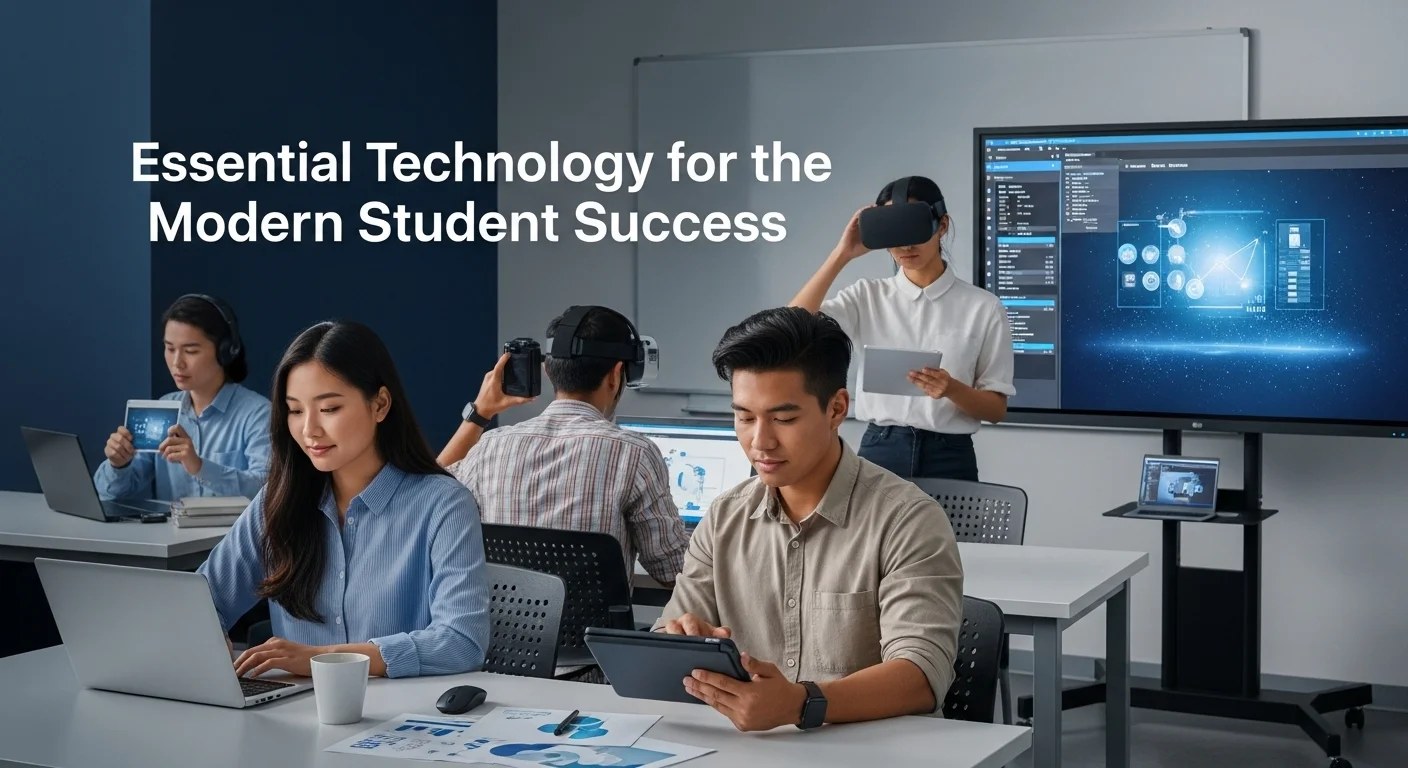The Modern Student's Tech Toolkit: Your Ultimate Guide to Success

Executive Summary
Let's be honest, being a student today means being surrounded by technology. It’s not just for taking notes anymore; it's your library, your study group, and your launchpad for a future career. In my years as an EdTech specialist, I've seen firsthand how the right tools can completely change the game. This guide is my way of sharing what I've learned. We'll walk through the essentials, starting with how to pick the perfect student laptop that will be your trusted partner for years. Then, we'll dive into the software you can't live without, like the free Office 365 suite that so many schools offer. We'll also explore the incredible power of cloud platforms like Azure, which gives you access to professional-grade tools for free. Whether you're studying art history or artificial intelligence, this guide will help you build a tech toolkit that not only gets you through your exams but also prepares you for the professional world ahead.
Table of Contents
Your Guide to Essential Student Technology
Table of Contents
- What is the Modern Student's Tech Kit?
- Choosing Your Command Center: The Student Laptop
- The Software That Powers Your Studies
- Unlocking the Cloud with Azure for Students
- A Complete Guide to Your Tech Toolkit
- Deep Dive: Picking the Right Laptop for Your Major
- Mastering Your Software Arsenal
- Getting Practical with Azure for Students
- Pro Tips to Level Up Your Tech Game
- Staying Safe and Secure in the Digital World
- Productivity Hacks for the Busy Student
- Using Tech to Build Your Future Career
What is the Modern Student's Tech Kit?
Let me tell you, being a student today is a world away from what it was just a decade ago. Technology isn't just an accessory; it's woven into the very fabric of your education. You're no longer just sitting in a lecture hall; you're an active participant in a massive, connected learning environment. I've seen this shift firsthand, and it's clear that your relationship with technology is what will shape your success. It’s your library, your research assistant, your connection to classmates and professors, and your workshop for creating amazing things. For businesses, understanding this is huge—because the tech-savvy student of today is the person who will be innovating and leading their company tomorrow. This deep connection between students and technology is what's paving the way for the future of, well, everything.
Choosing Your Command Center: The Student Laptop
At the heart of it all is your most essential piece of gear: the student laptop. Think of it as your portable command center. This machine is so much more than a fancy typewriter; it’s where you'll run specialized course software, access endless online resources, and collaborate with your peers. I’ve seen students struggle with slow, unreliable machines, and it directly impacts their ability to learn. Making the right choice here is critical. You need to consider things like processing power (the 'brain' of the computer), memory (RAM for multitasking), storage (a fast SSD is a must), and battery life. For someone studying computer science, a powerful processor is key for coding, while a design student will need a screen that shows true-to-life colors. Your laptop is your main gateway to your education, so choosing wisely is your first major assignment.
The Software That Powers Your Studies
Once you have the hardware, it's the software that brings your learning to life. The undisputed champion here is the Office 365 student package. The best part? Most universities and colleges offer it completely free to their students. This isn't just about having Word to write your essays. You get access to a whole ecosystem of powerful tools. Excel for analyzing data, PowerPoint for nailing your presentations, and OneNote for keeping all your class notes perfectly organized. But it gets even better. Your Office 365 plan likely includes Microsoft Teams, which is a lifesaver for group projects, and a huge chunk of OneDrive cloud storage. This means you can write an essay on your laptop, review it on your phone while waiting for a coffee, and share it instantly with your group—all seamlessly. This kind of integrated workflow isn't just a convenience; it's how modern, efficient learning gets done.
Unlocking the Cloud with Azure for Students
Now, let's talk about leveling up with cloud computing. One of the most incredible resources out there is the Azure for Students program from Microsoft. This initiative gives you free access to Microsoft Azure, a powerful cloud platform used by Fortune 500 companies, without needing a credit card. For most students, this could be a great way to host a personal portfolio website. But for a technology student, it's like being handed the keys to a digital kingdom. Imagine having a professional-grade sandbox where you can build and experiment. You can set up virtual servers to test code, use AI services to create intelligent apps, or manage a database for a project. I've mentored students who used their Azure credits to build projects that landed them their dream internships. It closes the gap between classroom theory and real-world skills, giving you hands-on experience that employers are desperately looking for.

A Complete Guide to Your Tech Toolkit
Alright, let's get practical. With so many tech options out there, it's easy to feel lost. This is your step-by-step guide to choosing the right hardware, mastering the software, and leveraging cloud services to your advantage. My goal is to help you make smart choices that fit your specific needs as a student.
Deep Dive: Picking the Right Laptop for Your Major
Choosing your student laptop really depends on what you're studying. Let's break it down. If you're in the humanities, business, or social sciences, your primary tasks will be writing, research, and presentations. A lightweight, portable laptop with great battery life, like a MacBook Air or a Windows Ultrabook, will be your best friend. But if you're a technology student—think engineering, computer science, or data analytics—your needs are much more intense. I always advise these students to invest in a machine with a powerful processor (like an Intel Core i7 or AMD Ryzen 7), at least 16GB of RAM (32GB if you can swing it), and a roomy, fast Solid-State Drive (SSD). Why? Because you'll be compiling code, running power-hungry software, and maybe even dabbling in machine learning, all of which demand serious horsepower. Some of you might even need a dedicated graphics card for 3D modeling or AI work. Don't just look at the price tag; read reviews and compare specs to find a machine that won't hold you back.
Mastering Your Software Arsenal
Having the right student software is one thing; knowing how to use it like a pro is another. We've talked about the Office 365 student suite, but let's go beyond the basics. Get comfortable with Microsoft Teams for group projects—create channels, share files, and hold meetings all in one place. Make OneNote your digital brain; you can create a notebook for each class, embed lecture slides, and record audio. It's a game-changer for staying organized. But don't stop there. I highly recommend a reference manager like Zotero or Mendeley. These tools automatically save, organize, and cite your research sources, which will save you hours of headache on big papers. For any aspiring technology student, mastering Git and GitHub is non-negotiable. It's the industry standard for managing code and collaborating on projects. Think of your GitHub profile as your professional portfolio before you even graduate.
Getting Practical with Azure for Students
The Azure for Students program can feel intimidating, but it's an incredible resource. So, how do you start? First, sign up with your university email—it's usually a quick verification process. Once you're in, a great first project is to build and launch a personal portfolio website. You can write the code on your student laptop and deploy it using Azure App Service. It’s a fantastic way to learn the fundamentals of the cloud and have something impressive to show recruiters. Feeling more ambitious? Try using Azure Machine Learning to analyze a public dataset, or build a simple 'serverless' app with Azure Functions that texts you the weather every morning. By working on these hands-on projects, you're not just learning abstract concepts; you're building real, marketable skills that businesses value. You're turning 'the cloud' into your personal innovation lab.
From a business point of view, this whole student tech ecosystem is a goldmine. Companies providing free tools like Office 365 student and Azure for Students are smartly investing in their future user base and talent pool. For other businesses, it's a direct line to finding the next generation of leaders. When I was consulting, we'd look for student GitHub profiles with interesting Azure projects. It told us they were curious, proactive, and had practical skills. The modern student isn't just a consumer; they are a creator. By understanding the tools they use, businesses can find better ways to recruit talent and build products that truly serve the next generation.

Pro Tips to Level Up Your Tech Game
Having the tools is one thing. Using them like a pro is another. To really make your technology work for you, you need a strategy. This is about being more secure, more efficient, and always learning. These are the habits that will set you apart, both in university and in your future career.
Staying Safe and Secure in the Digital World
First things first: digital security. It's not the most exciting topic, but it's absolutely essential. Start with your student laptop. Use a password manager to create strong, unique passwords for every account—trust me, you won't regret it. Always enable two-factor authentication (2FA) when it's offered. Keep your operating system and all your student software updated to protect against vulnerabilities. Be incredibly cautious of phishing emails, which often target student accounts to steal login details. One of my biggest pieces of advice? Get a good VPN (Virtual Private Network). When you're using public Wi-Fi at a café or library, a VPN encrypts your traffic and keeps your data safe from prying eyes. These simple habits are what I call good 'digital hygiene,' and they're crucial for protecting your work and your identity.
Productivity Hacks for the Busy Student
As a student, your time is your most precious resource. Let's find ways to get some of it back. Your Office 365 student account is packed with features for this. In Outlook, set up rules to automatically sort your emails. In Word, learn to use the 'Styles' feature to format your essays—it makes creating a table of contents automatic and saves so much time. For any technology student, learning the keyboard shortcuts for your code editor and terminal will make you a faster, more efficient coder. Look into simple automation tools, too. A service like IFTTT (If This Then That) can connect your apps to do things automatically, like saving articles you tag to a specific folder. These small tweaks add up, giving you more time to focus on what really matters: learning.
Using Tech to Build Your Future Career
For any student, but especially a technology student, your goal should be to use these tools to build your resume before you even have one. That Azure for Students account is your ticket. Don't just do tutorials; build a real, impressive project. Create a full web application, a mobile app with a cloud backend, or a data project that tackles a real-world problem. Document everything you do, host the code on GitHub, and write a blog post about it. This is the kind of tangible proof of skill that makes employers' eyes light up. Another pro move is to study for a certification. Using what you learn in class and with your Azure account, you can pass an entry-level exam like the 'Microsoft Certified: Azure Fundamentals (AZ-900)'. It's a formal credential that validates your skills. Get active in the community, contribute to open-source projects, and build your professional network. This is how you turn your student tech experience into a career launchpad.
Finally, never stop being resourceful. The tech world moves fast. The single best resource I recommend to every student is the GitHub Student Developer Pack. It is an absolute treasure chest of free professional tools, services, and software that would normally cost thousands of dollars. It includes everything from cloud hosting credits to domain names. When you combine your free university software, your Azure for Students account, and the GitHub pack, you have a world-class development environment for zero cost. By embracing security, focusing on efficiency, building a portfolio, and staying curious, you can transform technology from just a school requirement into your most powerful asset for success.
Expert Reviews & Testimonials
Sarah Johnson, Business Owner ⭐⭐⭐
As a business owner, I found the information on student tech accurate. I would have loved to see more practical examples on how we can use this knowledge to recruit top talent.
Mike Chen, IT Consultant ⭐⭐⭐⭐
This is a solid overview of the student tech world. It helped me get a better grasp of the available tools. I do think the section on Azure could be broken down a bit more for total beginners.
Emma Davis, Tech Expert ⭐⭐⭐⭐⭐
What an excellent article! It's a truly comprehensive guide to the technology a modern student needs. It was perfect for my specialization, and I found it incredibly easy to understand.



